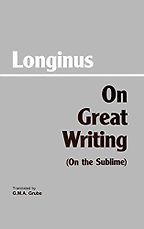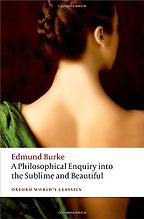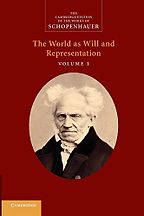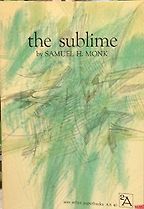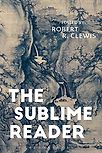I think we should start by defining our terms. As you have written, “not everyone who uses the term ‘sublime’ has the sublime in mind.” So: what are we talking about when we talk about the sublime?
The way I conceive of it, the sublime is a complex but ultimately pleasant feeling of exhilaration, excitement, or uplift, before an object that is considered to be powerful, vast, or awe-inspiring. It is usually perceived from a position of safety, or at least the perception of safety. The objects that elicit it can be natural or artefactual. Typical examples are natural wonders and marvels like waterfalls, storms, hurricanes… the Grand Canyon is a famous example. But also cathedrals, dams, ancient ruins.
I had thought, until I read your collection The Sublime Reader, that the sublime was a concept peculiar to Western art and philosophy. Not so. Could you say a little bit about your taking a more multicultural approach to this idea?
One of the aims I had for the Reader was to expand the canon a little bit. I included texts by Guo Xi, the Chinese painter and theorist, also Bharata-Muni and Zeami. Of course, they’re not using the word sublime, but I took them to be writing about something very similar, and in all three cases they were talking about the arts—an aesthetic experience on stage, in theatre, or in the case of Guo Xi, in a painting.
His was a particularly interesting case—he was a theorist of painting and wrote about the different perspectives you can take in a painting in a way that is, I think, quite reminiscent of Kant on the sublime—the mathematical sublime, the one of vastness, and also the kind of overpowering one, what he calls the ‘dynamical sublime.’
I suppose this is all pointing towards this idea of the sublime as being an emotional response that is, perhaps, universal. Is that fair to say?
Well, that’s a presupposition of my approach. But it is controversial.
There is the idea out there that the sublime is a construction of the West in a particular time, and is associated with Romanticism. This is an idea sometimes put forward by people in art history and literature, more so than in psychology. I’m more inclined toward the approach taken in psychology, which sees it as related to basic emotions like fear—even if it is not itself a basic emotion. This, of course, becomes philosophically interesting.
We might think of it as having cultural variations, the way there is a basic disgust response—but what we find disgusting varies over time and place.
Right. Well, let’s discuss your book recommendations in chronological order, starting with Longinus’s ‘On the Sublime.’ You have described it as “the first significant extant treatise on the topic.” Could you tell us about it?
I think you have to put him at the top of the list, just because he sort of got it all going. We have no treatises on the sublime without his work on the sublime. I don’t know if it’s accurate to say he wrote the first one, but it’s certainly the one that has survived the longest, so I think he’s significant for that reason alone.
As a little aside: it’s sometimes thought that Boileau, Nicolas Boileau, was the first translator of Longinus in his work of 1674. But that’s not completely accurate. Boileau did a lot to bring the sublime into mainstream intellectual discourse, particularly in continental Europe, but he wasn’t the first. Translations of Longinus started around the 1550s and 1560s; the treatise seems to have been published in Greek and Latin around the same time. So it was around for many decades before Boileau.
“The sublime is a complex but ultimately pleasant feeling of exhilaration, excitement, or uplift, before an object that is considered to be powerful, vast, or awe-inspiring”
As for the content, his main contribution there I would say was to break the sublime up into its sources, and he named five sources. The first two were really influential and stayed with us; the last three less so, they had more to do with rhetoric. One of his aims was to help orators stimulate and move an audience, so it was a kind of advice for orators.
But, he says, first and foremost is the power to conceive great thoughts. That’s the first source of sublime power. The second is strong, inspired emotion—the Greek he uses is ‘pathos’. Then thirdly, certain kinds of rhetorical figures; fourthly, noble diction; and fifth, dignified word arrangement.
So: ‘greatness of thought’. This seems to be a kind of Stoic idea, in other words, it is reason that is ultimately sublime, or elevated over nature. He says “sublimity is the echo of the great soul.” That is, I think, an idea that Kant later extends.
The strong and powerful emotion—this, of course, is very important to the psychological approach and to Burke. So I would say greatness of thought and powerful emotion are the two elements you can find in the Longinus work that have really stayed with us.
It’s interesting the way this term ‘the sublime’ might be applied to rhetoric, it might be applied to natural scenes, to drama. There’s even talk of ‘the technological sublime.’ It feels like a shapeshifting concept.
You’ll quickly find all sorts of adjectives put before the word sublime. My understanding is that, from a grammatical point of view, it’s just putting the elicitor of the experience there. The natural sublime is the sublime response elicited by nature, the technological sublime is the sublime response in response to technology, and so forth. I’m not too troubled by this. I think it’s perfectly fine for the concept to be applied in many ways.
Got it. Let’s move on to your next landmark book on the sublime. This is Edmund Burke’s A Philosophical Enquiry into the Origin of Our Ideas of the Sublime and Beautiful from 1757. It concentrates, and correct me if I’m wrong, on empirical descriptions of the sublime.
That’s right. I think he belongs on this list as he offers an original scientific—we might say physiological—investigation of the sublime and the beautiful, while at the same time holding on to an objectivist view somehow. So we get both the subjective side and the objective side in one theory.
What I mean by that is he gives us a list of qualities that are supposed to elicit the sublime. So: obscurity, darkness, towering heights, irregularity, being hidden and unknown, and so forth. Think of entering a cave, something like that. This idea was very influential on Gothic writers like Mary Shelley and Ann Radcliffe, also included in my Reader. So that was quite influential, particularly in British writing.
He also laid the foundations for empirical investigations in psychology today. In other words, he’s widely cited in the psychology literature, and I think that’s no coincidence.
I know that a lot of the research in this area talks about ‘awe’ as the key emotion. Do you see any difference between the sublime and awe?
That’s a profound question. I got into working with empirical psychologists working on awe after one day hearing an interview with one of my later co-authors. I thought, wait a second, you’re talking about the sublime! So I reached out to him, and we got along really well. We’ve since worked on a couple of papers together. I also published a philosophical paper of my own arguing that the sublime is aesthetic awe. So the sublime is a kind of awe, but not to be confused with what’s called socio-political awe, a response to a powerful leader, nor is it religious awe, which is typically the response to a divine being of some kind.
Of course, that raises the question, ‘what is the aesthetic?’ But I think that the basic intuition is right, and that’s why there’s a lot of intersection between philosophy and psychology here. There’s more work to be done, and I’ve found the psychologists to be open to this and willing to have dialogue, so that’s very promising.
Just briefly, you touched on the religious aspect. I think your reading of the sublime versus the religious or transcendent is that they are sister emotions of some kind.
That’s right. I think you could take the history of the sublime in a very different direction if you looked at religious experience, and focused on religious texts from, say, Taoism and some from the Buddhist traditions. But I didn’t do that in my Reader, partly just for practical reasons—if you did that, you would miss out on the whole approach offered by philosophical aesthetics.
Burke does talk about God, actually, and so does John Dennis, who is influential on Burke. In his own way, even Kant does. But by the time you get to Kant, and I think you already see this in Burke, the sublime has already been thought of as an aesthetic phenomenon. So I think it would be misleading to focus on that as if they had equal weight in the history. Since modernity, the sublime has really been an aesthetic concept.
Well, let’s talk about Kant next. He wrote first on the sublime in 1764, but more influential was the section of his 1790 book, Critique of the Power of Judgement, called ‘Analytic of the Sublime.’ What is the Kantian sublime?
Kant divides the sublime into two main kinds: the mathematical sublime and the dynamical sublime. It’s a bit jargony, but it’s a matter of what facet of reason is in relation to the imagination. Generally, the sublime is an aesthetic experience in which the imagination is in an ultimately harmonious relation between imagination and reason. In the mathematical case, it is theoretical reason—because this is what gives us the idea of the infinite—and in the other case, it’s practical reason. This is the kind of sublime that we feel when confronted with something that threatens us, like a storm or hurricane. The idea here is that we have a sensory disclosure of our own freedom. And it is practical reason that is being disclosed.
The Kantian take on the sublime was so incredibly influential that it seems, at least to an outsider, that all writings that follow seem to be classed either as ‘pro-Kant’ or ‘anti-Kant.’
I think that’s right. We’re going to talk about Schopenhauer in a moment. He very much takes up the dynamical sublime, more than anything, in his examples. Certainly, much of the writing either seems to go back to Burke or to Kant, depending on whether you are more psychologically oriented or more philosophically—maybe literarily—oriented.
Would you like to know why I put Kant on the list? Apart from his being enormously influential.
Please.
He really defends the idea that the experience of the sublime has a universal validity, as we were saying earlier. So it’s not just something you feel that is personal or a matter of preference, but something that all human beings share, and in the same circumstances would very likely agree on, or would have that same response.
This is called ‘transcendental’ philosophy, or it is an element of his transcendental philosophy. But at the same time, he’s very sympathetic to Burke. I think he calls him the “foremost author” of the “physiological and psychological method.” What’s interesting in Kant is it’s kind of combining the two approaches, even though the book itself is a work of transcendental philosophy. He’s very much open to the empirical approach, he just thinks that the problem with Burke’s approach is that it doesn’t account for the experience’s necessity and universal validity.
Let’s move onto Schopenhauer. You’ve selected section 39 from World as Will and Idea, or World as Will and Representation, depending on the edition.
I personally think ‘Representation’ is better. ‘Idea’ is ‘Idee’ in German. The ‘Vorstellung’ of the original title is really ‘Representation’. That’s my preferred translation.
What I really admire in this theory is the notion of a continuum of responses. He gives us the idea that, at the beginning, the sublime not so different from beauty. But eventually you arrive at what he calls “the full impression of the sublime.” The examples he gives begin with the setting sun: a winter scene of the rays of the setting sun, reflected by masses of stone. Then you have solitude: he gives the example of the North American prairies. Then bare rocks or desert. Then comes the Kantian examples: overhanging cliffs, rushing masses of water, storms, perhaps. Then we finally get to an overwhelming, raging waterfall. It’s so loud we can’t even hear the sound of our own voices. Or, it’s a storm with such howling wind and lightning and thunder claps, we can’t hear anything else. The idea is that the self feels annihilated. We are powerless against nature. This is very close to Kant, still, I think.
Get the weekly Five Books newsletter
But here’s where it differs—you get Schopenhauer’s ideas on metaphysics here—the subject feels himself or herself “the eternal, serene subject of knowing” who is the “supporter of this whole world.” Therefore he thinks that the sublime gives insight into the world as it actually is in itself. So you can see his unique combination of a kind of Platonism and Indian philosophy. He quotes the Vedas in this section. It’s just a really interesting moment in his philosophy.
Unlike Longinus’s work, the book is not a treatise on the sublime. In fact, none of the other three are. But it’s a really well-written section from one of the great stylists of German philosophy. To me, the intriguing idea is this notion of the continuum.
Right, because this relationship between beauty and the sublime—it’s been a source of some contention, right? Is it a subsection of beauty, or are they two separate things?
Exactly. Schopenhauer’s answer is not completely clear. Because he distinguishes them, but he doesn’t do it in the way Kant does, which is more rigid, you might say more clear-cut. Still, Schopenhauer thinks there’s some difference between the two kinds of experience: beauty is felt to be in harmony with our perceptive faculties, is easily comprehended. But the sublime stands in contrast to our abilities to perceive. Even more than that: threatens our very feeling of life.
That’s helpful. Yes. Thank you. And maybe I can lead us on to your final book recommendation, which is Samuel Monk’s The Sublime: A Study of Critical Theories in XVIII-century England. It was a landmark study, first published in 1935. Why do you think it is still worth reading today?
I think it’s a very helpful overview for people interested in eighteenth-century English theories of the sublime. It is, I admit, somewhat dated—though there was a second edition in 1960 –but it’s still widely cited. And despite it being limited to discussing a specific period, it’s still quite useful. So, in other words, this book by Monk has passed the test of time, if you’re looking for an overview.
I have to say, your book The Sublime Reader is very helpful. For the benefit of our readers: this book presents key passages from writing on the subject from the ancients to the present day.
Besides my own Reader, I could also recommend The Sublime by Philip Shaw, there is a second edition from 2017. That’s from the perspective of literary theory, which is different from the philosophical approach, but I’d recommend it as well.
The sublime is a concept with ancient roots, but still feels very much a contemporary concern—I’m thinking, I suppose, of the burgeoning outdoor pursuits industry. Is there still critical thought in this area too?
Two main areas come to mind. The first is environmentalist aesthetics, even environmental ethics. I’d point you to Emily Brady’s book The Sublime in Modern Philosophy: Aesthetics, Ethics, and Nature. Kant’s examples paradigmatically come from nature, rather than art. So people interested in the natural environment really focus on that element. As an aside, I’ll say that it’s somewhat controversial whether Kant’s theory allows for the possibility of artistic sublimity. I myself think that it does, but people writing in environmental aesthetics tend to deny that.
The other area is, of course, psychological. The various ways that this work is conducted tend to go back to Burke. As I mentioned, I’m interested in continuing to explore the sublime and awe with empirical psychologists. In one study, we looked at whether painting and natural scenery can evoke the sublime, and we found, using virtual reality goggles, that they do, although they do so in different ways. They’re both capable of eliciting it, but the natural scenery of a starry sky gives you more of a sense of being present, and also threatens the person a little more.
And do you find yourself in search of the sublime in your own life?
Well, every time I see the Swiss Alps, or any other enormous mountain range, I do. I’m enthralled by such experiences. I’ve often wondered why that is. I grew up in Florida, where 300 feet counts as elevation, so maybe it’s filling in this gap in my own upbringing.
Interview by Cal Flyn, Deputy Editor
December 19, 2022. Updated: October 3, 2023
Five Books aims to keep its book recommendations and interviews up to date. If you are the interviewee and would like to update your choice of books (or even just what you say about them) please email us at [email protected]
Five Books interviews are expensive to produce. If you've enjoyed this interview, please support us by donating a small amount.
